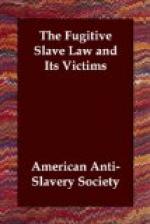The House of Delegates of Virginia, early in 1856, adopted the following:—“Be it resolved by the General Assembly, That our Representatives in Congress are requested, and our Senators be and are hereby instructed, to secure the passage of a law making full compensation to all owners whose slaves have or may hereafter escape into any of the non-slaveholding States of this Union, and there be withheld from those to whom such service or labor may be due.”
Fourteen persons of color, held at Los Angelos, California, early in 1856, as the servants of one Robert Smith, were brought before Judge Benjamin Hays, on a writ of habeas corpus. Smith alleged that he formerly resided in Mississippi, where he owned these persons; was now about to remove to Texas, and designed to take these persons with him as his slaves. Judge Hays decided that they were all free, and those under twenty-one years of age were placed in the charge of the sheriff, as their special guardian.—Los Angelos Star. The opinion of Judge Hays (who was said to be a native of South Carolina,) is a very able one, and under the circumstances, of much interest. It may be found in the Standard, of April 5, 1856.
Two colored lads, named RALLS and LOGAN, living in Cincinnati, were kidnapped thence by two men, named Orr and Simpkins, and taken to St. Louis, Missouri, where the men tried to sell them. The men were arrested as kidnappers. (March, 1856.)
The Decatur (Illinois) Chronicle states that “a man charged with being a fugitive slave was recently arrested at that place and carried off, no one knows where. The sheriff of the county was the willing instrument in the hands of the claimants; no attempt to appeal to the law was made, the negro being carried off as if he were a stray horse or dog.” The Chicago Tribune says: “If this is a true statement of the affair, that sheriff has laid himself liable to the charge of kidnapping, and should at once be proceeded against with such rigor as his offence demands.” (April, 1856.)
MARGARET GARNER and seven others, at Cincinnati, Ohio, January, 1856. Of this recent and peculiarly painful case we give a somewhat detailed account, mainly taken from the Cincinnati papers of the day.
About ten o’clock on Sunday, 27th January, 1856, a party of eight slaves—two men, two women, and four children—belonging to Archibald K. Gaines and John Marshall, of Richwood Station, Boone County, Kentucky, about sixteen miles from Covington, escaped from their owners. Three of the party are father, mother, and son, whose names are Simon, Mary, and Simon, Jr.; the others are Margaret, wife of Simon, Jr., and her four children. The three first are the property of Marshall, and the others of Gaines.
They took a sleigh and two horses belonging to Mr. Marshall, and drove to the river bank,




